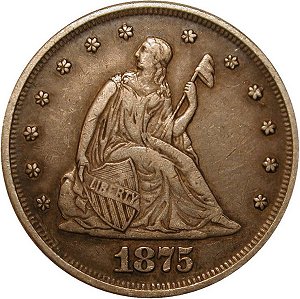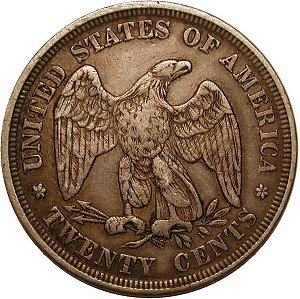NOTE February 2018:
A new obverse die (Obverse 3) has been identified and another die marriage (BF-3). This is now detailed in the page below, and on the new page for BF-3. In addition, the pages for
the BF-1 and BF-2 have also been updated.
An addendum that can be downloaded, printed, and inserted in the Print Edition is available by clicking the link here:
1875-P Addendum February 2018, PDF, 6.1 mb


Mintage:
Circulation strikes: 36,910
Proof strikes: 2,790
Major Varieties:
None
Overall Scarcity:
One of the two scarcer regular issue circulation strikes, this date can sometimes be a challenge to locate in all grades, although they can be found with some looking at larger coin shows.
Most examples are in middle to higher circulated grades, with lower grade coins infrequently seen.
Some nice mint state coins were saved as well, and most of these can be obtained at auction, or occasionally on the bourse floor of a larger show.
The date is underrated because of its Philadelphia origin and perhaps the misconception that coins struck in Philadelphia are more common. Until recently,
1875-P coins were not much more frequently seen than the 1876-P coins, which have a much lower mintage. 1875-P appears more often than 1876-P now,
but this is more due to the 1876-P coins drying up in the market than an increase in availability of the 1875-P coin. As more people collect this series, it is likely
that the 1875-P coins will command a significantly higher price than at present.
Comments:
This coin is frequently found well struck and with pleasant surfaces, even with highly circulated pieces, so there is really little need to settle for an impaired or
unattractive coin. Many circulation strikes are proof-like with reflectivity remaining even on moderately circulated examples. Occasionally a circulated proof
can be found and some may even be offered as circulation strikes. Despite recent price gains, the 1875-P remains undervalued.
Die Marriages:
Three obverse and two reverse dies were used to strike all known coins, including a newly-discovered obverse that is very similar to the second obverse.
One pair of dies accounts for the vast majority of both proof and circulation strikes. .

Die Marriage Grid for the 1875-P
Apparently, the newly-discovered Obverse 3 (Left Date #2) was paired with Reverse A and struck very few pieces (BF-3), and then was replaced with Obverse 1 (Right Date) to strike the majority of 1875-P coins (BF-1).
With the most frequently-seen die pairing (BF-1), there are two distinctly different die states and are distinguished by the presence or absence of die polish marks. It appears that at some point after striking a number of proof and circulation strikes, the obverse die received some vigorous re-polishing for striking additional proof examples. This die work left swirling die polish lines at the top of the obverse and to the right and left of Liberty’s head. These die polish marks also appear on the subsequent circulation strikes that followed this second batch of proof strikes.
Finally, a different pair of dies (Obverse 2 and Reverse B) were employed to strike a modest number of coins (BF-2) at a later time to wrap up the year’s issues.
Important note:
From an attribution perspective, the two “Left Date” obverses are almost identical, but this does not pose a difficulty for the collector, as the two different Left Date obverses are paired with different reverse dies. Therefore, a Left Date obverse paired with Reverse A is BF-3, and a Left Date obverse paired with Reverse B is BF-2. All Right Date coins seen thus far are the most common variety, BF-1.
